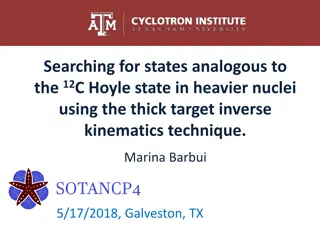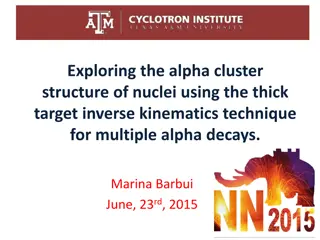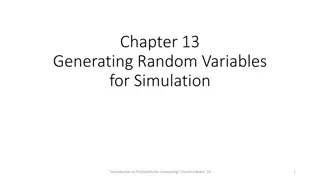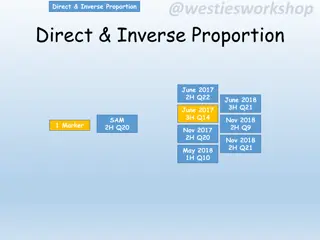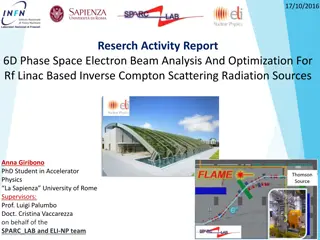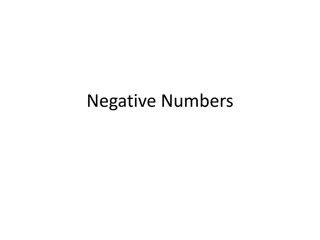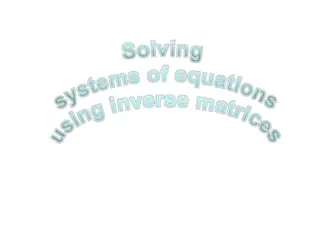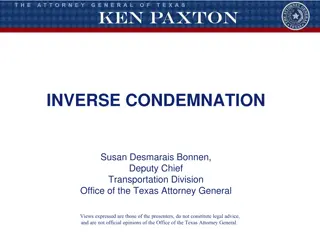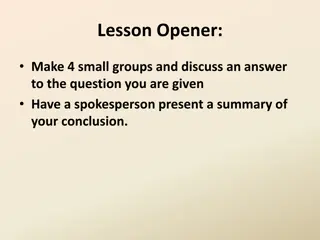Overview of Army Modeling and Simulation Office
The U.S. Army Modeling and Simulation Office (AMSO) serves as the lead activity in developing strategy and policy for the Army Modeling and Simulation Enterprise. It focuses on effective governance, resource management, coordination across various community areas, and training the Army Analysis, Mod
1 views • 8 slides
Capacity Zone Modeling for Forward Capacity Auction 17 Results
This presentation unveils the Capacity Zone modeling calculations for Forward Capacity Auction 17 associated with the 2026-2027 Capacity Commitment Period by ISO-NE PUBLIC. It delves into boundary definitions, import-constrained zone modeling, and market rules guiding the assessments and modeling pr
0 views • 16 slides
Distribution Feeder Modeling and Analysis Overview
This document delves into the modeling, optimization, and simulation of power distribution systems, specifically focusing on Distribution Feeder Modeling and Analysis. It covers the components of a typical distribution feeder, series components, Wye-Connected Voltage Regulator modeling, and equation
0 views • 14 slides
Understanding Data Modeling vs Object Modeling
Data modeling involves exploring data-oriented structures, identifying entity types, and assigning attributes similar to class modeling in object-oriented development. Object models should not be solely based on existing data schemas due to impedance mismatches between object and relational paradigm
0 views • 17 slides
Evolution of Modeling Methodologies in Telecommunication Standards
Workshop on joint efforts between IEEE 802 and ITU-T Study Group 15 focused on information modeling, data modeling, and system control in the realm of transport systems and equipment. The mandate covers technology architecture, function management, and modeling methodologies like UML to YANG generat
1 views • 16 slides
Understanding Geometric Modeling in CAD
Geometric modeling in computer-aided design (CAD) is crucially done in three key ways: wireframe modeling, surface modeling, and solid modeling. Wireframe modeling represents objects by their edges, whereas surface modeling uses surfaces, vertices, and edges to construct components like a box. Each
1 views • 37 slides
Understanding Hyperbolic Functions and Their Inverses
This content delves into the world of hyperbolic functions, discussing their formation from exponential functions, identities, derivatives, and inverse hyperbolic functions. The text explores crucial concepts such as hyperbolic trigonometric identities, derivatives of hyperbolic functions, and integ
0 views • 9 slides
Mathematical Modeling and Error Analysis in Engineering
Mathematical modeling plays a crucial role in solving engineering problems efficiently. Numerical methods are powerful tools essential for problem-solving and learning. This chapter explores the importance of studying numerical methods, the concept of mathematical modeling, and the evaluation proces
0 views • 10 slides
Introduction to Dynamic Structural Equation Modeling for Intensive Longitudinal Data
Dynamic Structural Equation Modeling (DSEM) is a powerful analytical tool used to analyze intensive longitudinal data, combining multilevel modeling, time series modeling, structural equation modeling, and time-varying effects modeling. By modeling correlations and changes over time at both individu
0 views • 22 slides
Understanding Inverse Probability Weights in Epidemiological Analyses
In epidemiological analyses, inverse probability weights play a crucial role in addressing issues such as sampling, confounding, missingness, and censoring. By reshaping the data through up-weighting or down-weighting observations based on probabilities, biases can be mitigated effectively. Differen
0 views • 25 slides
System Modeling and Simulation Overview
This content provides insights into CPSC 531: System Modeling and Simulation course, covering topics such as performance evaluation, simulation modeling, and terminology in system modeling. It emphasizes the importance of developing simulation programs, advantages of simulation, and key concepts lik
0 views • 28 slides
Exploring States Analogous to 12C Hoyle State in Heavy Nuclei Using Inverse Kinematics
The study discusses the search for states similar to the 12C Hoyle state in heavier nuclei through the thick target inverse kinematics technique. It explores alpha clustering in nuclei, the thick target inverse kinematics method, events with alpha multiplicities, and more experimental details relate
0 views • 19 slides
Understanding Object Modeling in Software Development
Object modeling is a crucial concept in software development, capturing the static structure of a system by depicting objects, their relationships, attributes, and operations. This modeling method aids in demonstrating systems to stakeholders and promotes a deeper understanding of real-world entitie
1 views • 65 slides
Understanding Inverse Condemnation Law in North Carolina
Explore the nuances of inverse condemnation law, including its history, basis in fundamental constitutional rights, N.C. statutory framework, attorney fees, and major categories of inverse takings. Learn about the actions, burdens of proof, and legal principles involved in these cases.
0 views • 36 slides
Understanding the Inverse Relationship of Addition and Subtraction
Learn about the inverse relationship between addition and subtraction through examples and visual aids. Practice writing inverse number sentences and understand how addition and subtraction are opposite operations that involve rearranging the same numbers in a different order.
3 views • 11 slides
Coupled Ocean-Atmosphere Modeling on Icosahedral Grids
Coupled ocean-atmosphere modeling on horizontally icosahedral and vertically hybrid-isentropic/isopycnic grids is a cutting-edge approach to modeling climate variability. The design goals aim to achieve a global domain with no grid mismatch at the ocean-atmosphere interface, with key indicators such
1 views • 21 slides
Fire and Smoke Modeling Evaluation Effort (FASMEE) Overview
FASMEE is a collaborative project aimed at assessing and advancing fire and smoke modeling systems through critical measurement techniques and observational data. Led by key technical leads, FASMEE focuses on diverse modeling areas such as fire growth, effects, coupled fire-atmosphere behavior, smok
5 views • 30 slides
Subarea and Highway Corridor Studies: Travel Demand Modeling and Refinements
In this lesson, we delve into subarea and corridor studies focusing on travel demand model refinements, highway network coding, corridor congestion relief, and trip assignment theory. Subarea modeling plays a crucial role in forecasting travel within smaller regions with detailed traffic patterns, t
1 views • 45 slides
Essential Steps for Setting up a Modeling Study
Ensure clarity on modeling goals and uncertainties. Select sample areas strategically based on interest and available data. Determine appropriate resolution for modeling. Define variables to model and validate the model effectively. Assess sample data adequacy and predictor variables availability. E
0 views • 9 slides
Water Storage Tanks Hydraulic Modeling and Water Quality Considerations
This presentation by Justine Carroll, P.E., Project Manager, focuses on the hydraulic modeling and water quality considerations related to water storage tanks. It covers topics such as water age evaluation, steady state modeling, extended period simulations, pump controls, demand patterns, EPS verif
0 views • 34 slides
Exploring Alpha Cluster Structure in Nuclei Using Thick Target Inverse Kinematics Technique
Exploring the alpha cluster structure of nuclei through the thick target inverse kinematics technique for multiple alpha decays. This study investigates alpha clustering in nuclei, potential alpha condensates, and the application of the inverse kinematics technique in detecting multiple alpha emissi
0 views • 14 slides
Advancing Computational Modeling for National Security and Climate Missions
Irina Tezaur leads the Quantitative Modeling & Analysis Department, focusing on computational modeling and simulation of complex multi-scale, multi-physics problems. Her work benefits DOE nuclear weapons, national security, and climate missions. By employing innovative techniques like model order re
0 views • 6 slides
Flexible Framework for Stormwater Lids Modeling
A new flexible framework for forward and inverse modeling of stormwater lids is presented. It includes governing equations, hydraulic and contaminant transport, numerical methods, and demonstration cases for various green infrastructure components. The importance of different processes in modeling i
0 views • 20 slides
High-Resolution 3D Seafloor Topography Enhancement Using Kalman Filtering
Proposing a Kalman Filter approach to refine seafloor topography estimation by integrating various geophysical data types. The method allows for producing regional bathymetry with higher resolution, truncating unnecessary observations, and reducing the matrix dimensions in the inverse problem. Inclu
0 views • 9 slides
Understanding Automated Speech Recognition Technologies
Explore the world of Automated Speech Recognition (ASR), including setup, basics, observations, preprocessing, language modeling, acoustic modeling, and Hidden Markov Models. Learn about the process of converting speech signals into transcriptions, the importance of language modeling in ASR accuracy
0 views • 28 slides
Generating Random Variables Using Inverse Transform Method
Explore the Inverse Transform Method for generating random variables in simulations. Learn how to map random instances to desired distributions, whether continuous or discrete, by understanding cumulative distribution functions and inverting them. Examples and step-by-step explanations provided for
0 views • 24 slides
Understanding Composite and Inverse Functions
Learn about composite functions, inverse functions, and how to find their compositions and inverses through examples and step-by-step explanations. Explore the concept of forming composite functions, verifying inverse functions, and finding the inverse of a function using interchange and solving met
0 views • 15 slides
Understanding Direct and Inverse Proportion in Mathematics
Exploring the concept of direct and inverse proportion in mathematics through various questions from past exam papers. The content includes images illustrating how these proportional relationships work in different scenarios.
0 views • 24 slides
Electron Beam Analysis and Optimization for RF Linac in Inverse Compton Scattering
This research activity report discusses the analysis and optimization of a 6D phase space electron beam for RF Linac-based Inverse Compton Scattering radiation sources. It covers the SPARC_LAB Thomson Source and ELI-NP GBS, including experiments, simulations, and studies on beam parameters and struc
0 views • 26 slides
Update on Modeling and Coordination Discussions
Weekly coordination calls with Ramboll and discussions with EPA OAQPS leads focused on Regional Haze and modeling adjustments. Final draft of procedures document with visibility projections and glide slope adjustments. Upcoming RTOWG meetings covering methodology, projections, and modeling evaluatio
0 views • 5 slides
Importance of Data Modeling in Industrial Information Systems
Introduction to data modeling and design in Industrial Information Systems at King Saud University College of Engineering. The chapter covers the significance of data modeling, capturing data characteristics, structural information, and the role of databases and DBMS. Data modeling fills crucial gap
0 views • 51 slides
Understanding Negative Numbers and Additive Inverse
Explore the world of negative numbers and additive inverse through a series of mathematical exercises. Learn how to calculate sums involving negatives and discover the concept of additive inverses, where adding a number and its opposite results in zero. Test your understanding with various numerical
0 views • 21 slides
Solving Systems of Equations using Inverse Matrices
Learn how to solve systems of equations using inverse matrices, find the determinant of matrices, use matrix multiplication, calculate the inverse matrix, and apply it to solve simultaneous equations. Explore examples and applications in investment scenarios.
0 views • 14 slides
Understanding Image-Based Rendering and Light Fields
Exploring the concepts of Image-Based Rendering (IBR) and Light Fields through a historical perspective, pros and cons analysis, basic approaches, and recent developments in the field. IBR offers photorealistic image capture and representation, with advancements like data-driven graphics and appeara
0 views • 43 slides
NetLogo - Programmable Modeling Environment for Simulating Natural and Social Phenomena
NetLogo is a powerful and versatile programmable modeling environment created by Uri Wilensky in 1999. It allows users to simulate natural and social phenomena by giving instructions to multiple agents operating independently, making it ideal for modeling complex systems evolving over time. NetLogo
0 views • 7 slides
Robotic Kinematics & Control: Exploring Parallel Robots & Delta Robots
Discover the fascinating world of robotic kinematics and control through the exploration of parallel robots, Stewart platforms, inverse kinematics, forward kinematics, multiple solutions, and Delta robots. From understanding the structure of control variables to solving kinematic equations, this con
0 views • 15 slides
Solving Trigonometric Equations with Inverse Functions
Learn how to solve trigonometric equations using inverse trigonometric functions with step-by-step examples. Understand the concept of sin⁻¹, cos⁻¹, and tan⁻¹ functions to find angles corresponding to specific trigonometric values. Practice solving equations and converting angles to degrees
0 views • 4 slides
Understanding Inverse Condemnation: Legal Aspects and Case Studies
Explore the concepts of inverse condemnation, Serbonian Bog references, and the legal implications in Texas jurisprudence. Learn about typical and atypical claims, challenges faced by plaintiffs and defendants, and notable cases such as Harris Cty. Flood Control Dist. v. Kerr. Delve into government
0 views • 21 slides
Reservoir Modeling Using Gaussian Mixture Models
In the field of reservoir modeling, Gaussian mixture models offer a powerful approach to estimating rock properties such as porosity, sand/clay content, and saturations using seismic data. This analytical solution of the Bayesian linear inverse problem provides insights into modeling reservoir prope
0 views • 10 slides
Understanding Gravity and Inverse Square Relationships in Physics
Explore the concepts of gravitational field, potential, geostationary orbits, escape velocity, and the inverse square relationship in Newton's Law of Universal Gravitation. Discover how mass and distance affect gravitational force and learn about nonuniform gravitational fields and equipotential lin
0 views • 22 slides











